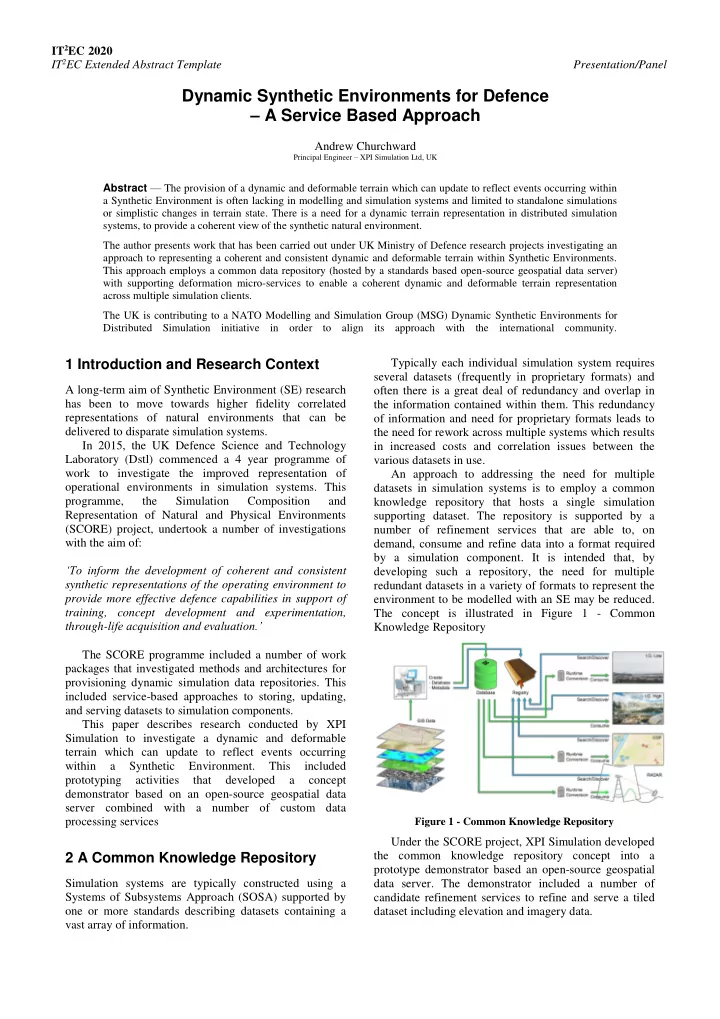

IT 2 EC 2020 IT 2 EC Extended Abstract Template Presentation/Panel Dynamic Synthetic Environments for Defence – A Service Based Approach Andrew Churchward Principal Engineer – XPI Simulation Ltd, UK Abstract — The provision of a dynamic and deformable terrain which can update to reflect events occurring within a Synthetic Environment is often lacking in modelling and simulation systems and limited to standalone simulations or simplistic changes in terrain state. There is a need for a dynamic terrain representation in distributed simulation systems, to provide a coherent view of the synthetic natural environment. The author presents work that has been carried out under UK Ministry of Defence research projects investigating an approach to representing a coherent and consistent dynamic and deformable terrain within Synthetic Environments. This approach employs a common data repository (hosted by a standards based open-source geospatial data server) with supporting deformation micro-services to enable a coherent dynamic and deformable terrain representation across multiple simulation clients. The UK is contributing to a NATO Modelling and Simulation Group (MSG) Dynamic Synthetic Environments for Distributed Simulation initiative in order to align its approach with the international community. 1 Introduction and Research Context Typically each individual simulation system requires several datasets (frequently in proprietary formats) and A long-term aim of Synthetic Environment (SE) research often there is a great deal of redundancy and overlap in has been to move towards higher fidelity correlated the information contained within them. This redundancy representations of natural environments that can be of information and need for proprietary formats leads to delivered to disparate simulation systems. the need for rework across multiple systems which results In 2015, the UK Defence Science and Technology in increased costs and correlation issues between the Laboratory (Dstl) commenced a 4 year programme of various datasets in use. work to investigate the improved representation of An approach to addressing the need for multiple operational environments in simulation systems. This datasets in simulation systems is to employ a common programme, the Simulation Composition and knowledge repository that hosts a single simulation Representation of Natural and Physical Environments supporting dataset. The repository is supported by a (SCORE) project, undertook a number of investigations number of refinement services that are able to, on with the aim of: demand, consume and refine data into a format required by a simulation component. It is intended that, by ‘To inform the development of coherent and consistent developing such a repository, the need for multiple synthetic representations of the operating environment to redundant datasets in a variety of formats to represent the provide more effective defence capabilities in support of environment to be modelled with an SE may be reduced. training, concept development and experimentation, The concept is illustrated in Figure 1 - Common through- life acquisition and evaluation.’ Knowledge Repository The SCORE programme included a number of work packages that investigated methods and architectures for provisioning dynamic simulation data repositories. This included service-based approaches to storing, updating, and serving datasets to simulation components. This paper describes research conducted by XPI Simulation to investigate a dynamic and deformable terrain which can update to reflect events occurring within a Synthetic Environment. This included prototyping activities that developed a concept demonstrator based on an open-source geospatial data server combined with a number of custom data processing services Figure 1 - Common Knowledge Repository Under the SCORE project, XPI Simulation developed the common knowledge repository concept into a 2 A Common Knowledge Repository prototype demonstrator based an open-source geospatial Simulation systems are typically constructed using a data server. The demonstrator included a number of Systems of Subsystems Approach (SOSA) supported by candidate refinement services to refine and serve a tiled one or more standards describing datasets containing a dataset including elevation and imagery data. vast array of information.
Recommend
More recommend